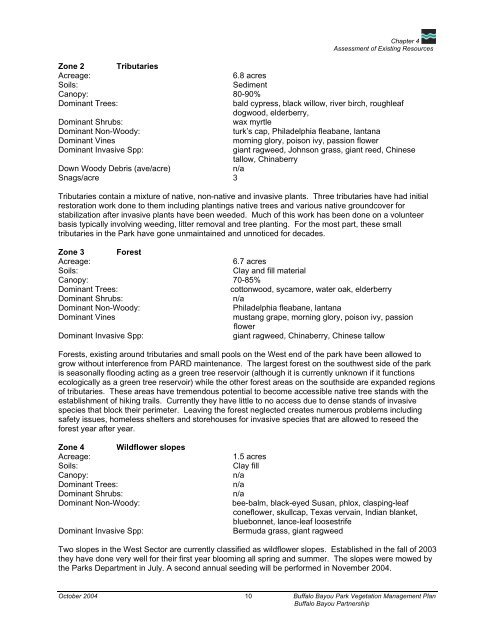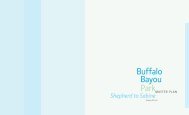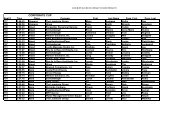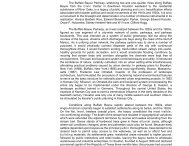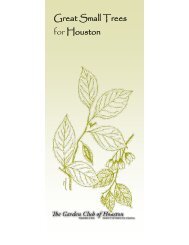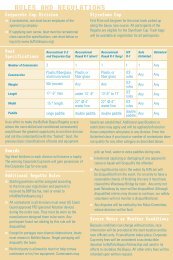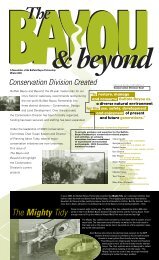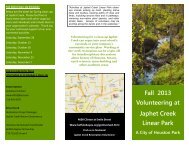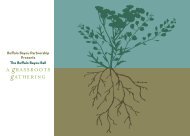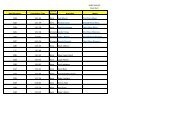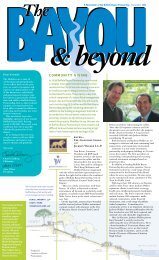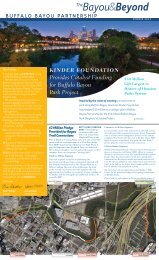Buffalo Bayou Park Vegetation Management Plan (PDF)
Buffalo Bayou Park Vegetation Management Plan (PDF)
Buffalo Bayou Park Vegetation Management Plan (PDF)
You also want an ePaper? Increase the reach of your titles
YUMPU automatically turns print PDFs into web optimized ePapers that Google loves.
Chapter 4Assessment of Existing ResourcesZone 2 TributariesAcreage:6.8 acresSoils:SedimentCanopy: 80-90%Dominant Trees:bald cypress, black willow, river birch, roughleafdogwood, elderberry,Dominant Shrubs:wax myrtleDominant Non-Woody:turk’s cap, Philadelphia fleabane, lantanaDominant Vinesmorning glory, poison ivy, passion flowerDominant Invasive Spp:giant ragweed, Johnson grass, giant reed, Chinesetallow, ChinaberryDown Woody Debris (ave/acre)n/aSnags/acre 3Tributaries contain a mixture of native, non-native and invasive plants. Three tributaries have had initialrestoration work done to them including plantings native trees and various native groundcover forstabilization after invasive plants have been weeded. Much of this work has been done on a volunteerbasis typically involving weeding, litter removal and tree planting. For the most part, these smalltributaries in the <strong>Park</strong> have gone unmaintained and unnoticed for decades.Zone 3 ForestAcreage:6.7 acresSoils:Clay and fill materialCanopy: 70-85%Dominant Trees:cottonwood, sycamore, water oak, elderberryDominant Shrubs:n/aDominant Non-Woody:Philadelphia fleabane, lantanaDominant Vinesmustang grape, morning glory, poison ivy, passionflowerDominant Invasive Spp:giant ragweed, Chinaberry, Chinese tallowForests, existing around tributaries and small pools on the West end of the park have been allowed togrow without interference from PARD maintenance. The largest forest on the southwest side of the parkis seasonally flooding acting as a green tree reservoir (although it is currently unknown if it functionsecologically as a green tree reservoir) while the other forest areas on the southside are expanded regionsof tributaries. These areas have tremendous potential to become accessible native tree stands with theestablishment of hiking trails. Currently they have little to no access due to dense stands of invasivespecies that block their perimeter. Leaving the forest neglected creates numerous problems includingsafety issues, homeless shelters and storehouses for invasive species that are allowed to reseed theforest year after year.Zone 4 Wildflower slopesAcreage:Soils:Canopy:Dominant Trees:Dominant Shrubs:Dominant Non-Woody:Dominant Invasive Spp:1.5 acresClay filln/an/an/abee-balm, black-eyed Susan, phlox, clasping-leafconeflower, skullcap, Texas vervain, Indian blanket,bluebonnet, lance-leaf loosestrifeBermuda grass, giant ragweedTwo slopes in the West Sector are currently classified as wildflower slopes. Established in the fall of 2003they have done very well for their first year blooming all spring and summer. The slopes were mowed bythe <strong>Park</strong>s Department in July. A second annual seeding will be performed in November 2004.October 2004 10 <strong>Buffalo</strong> <strong>Bayou</strong> <strong>Park</strong> <strong>Vegetation</strong> <strong>Management</strong> <strong>Plan</strong><strong>Buffalo</strong> <strong>Bayou</strong> Partnership


